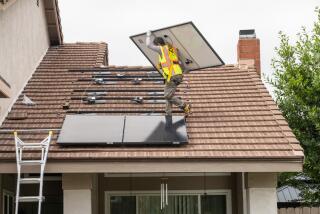Solar energy’s darker side stirs concern
- Share via
Everybody loves solar, the shiny superstar of renewable energy.
But scratch the surface of the manufacturing process and the green sheen disappears. Vast amounts of fossil fuels are used to produce and transport panels. Solar cells contain toxic materials. Some components can’t be easily recycled.
That has some environmentalists worried about a new tidal wave of hazardous waste headed for the nation’s landfills when panels eventually wear out. A report to be released today by the Silicon Valley Toxics Coalition warns that the industry and lawmakers need to set policies now to ensure that a clean technology doesn’t leave a dirty legacy.
“You can’t just call your product green and close your eyes to what’s happening in the supply chain,” said Sheila Davis, executive director of the San Jose nonprofit group that pushes for green practices in the technology sector.
“The solar energy industry is running into some of the same problems . . . we’ve seen in the electronics industry,” whose waste is polluting U.S. landfills and contaminating groundwater with harmful substances such as mercury and chromium, Davis said.
Solar energy supplies less than 1% of the nation’s electricity at present. But the technology is poised for explosive growth. Much of the world’s production is centered in Asia, where Davis said some disturbing trends were emerging.
China is major producer of polycrystalline silicon, a key component of solar cells. The Washington Post last year documented how at least one Chinese producer was dumping a toxic byproduct from that manufacturing process on nearby farmland. Experts suspect that firms in other developing countries are taking similar shortcuts.
Silicon isn’t the only conductor that can be used to convert sunlight to electricity. Companies are developing cells using other materials. Still, virtually all of them utilize hazardous chemicals that pose potential risks to workers and the environment, according to the coalition’s report.
Davis said developing benign substitutes for some of the most dangerous materials was essential for the solar industry to be truly sustainable.
Making the panels is just the beginning. Planning needs to begin now on what to do with millions of these heavy modules as they wear out in 20 to 25 years or are replaced with better technology, environmentalists say.
The high-tech industry generated more than 2.6 million tons of e-waste in the U.S. in 2005, about 87% of which ends up in landfills or incinerators, according to the report.
Most of the rest was exported to developing countries to be dismantled by low-wage workers, many of whom are exposed to dangerous substances lurking in the guts of personal computers and other electronics.
“We don’t want solar to go down that path,” Davis said.
She said local, state and national governments need to consider legislation to keep cleanup costs from falling to taxpayers. Conscious of protecting the industry’s clean and green reputation -- and probably eager to avoid mandates they don’t like -- some solar firms are taking action on their own.
In Europe, an industry group known as PV Cycle is pledging to collect and recycle its members’ solar panels before they become a major environmental hazard. The 17 companies that signed the accord manufacture the majority of panels there.
In the U.S., First Solar Inc., a Tempe, Ariz., manufacturer of thin-film photovoltaic modules, has developed what many in the industry are calling a model for so-called extended producer responsibility. That’s the notion that companies must take responsibility for the cradle-to-grave environmental effects of their products.
First Solar guarantees that it will take back all its solar panels from commercial customers at the end of the product’s life, said Lisa Krueger, the company’s vice president of sustainable development.
She said First Solar had made recycling those panels an integral part of its manufacturing process so very little material needs to go to a landfill. To back up its promise to customers, the company has funded an independent trust to handle the cost of the collection effort, ensuring that the panels would get recycled even if the company folds, Krueger said.
“We are in business to create environmental solutions,” she said. “What good does it do if we create waste problems” in the process?
--
More to Read
Inside the business of entertainment
The Wide Shot brings you news, analysis and insights on everything from streaming wars to production — and what it all means for the future.
You may occasionally receive promotional content from the Los Angeles Times.










